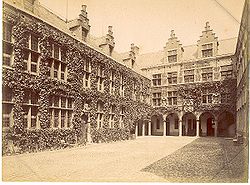Plantin-Moretus Museum
Coordinates: 51 ° 13 ′ 5.9 ″ N , 4 ° 23 ′ 53.4 ″ E
| Plantin-Moretus Museum | |
|---|---|
|
UNESCO world heritage |
|

|
|
| Inner courtyard of the museum in the 19th century |
|
| National territory: |
|
| Type: | Culture |
| Criteria : | (ii) (iii) (iv) (vi) |
| Surface: | 0.23 ha |
| Buffer zone: | 184.1 ha |
| Reference No .: | 1185 |
| UNESCO region : | Europe and North America |
| History of enrollment | |
| Enrollment: | 2005 (session 29) |
The Plantin-Moretus Museum at Vrijdagmarkt 22–23 in Antwerp goes back to the printing works of Christoph Plantin (Christoffel Plantijn) from the 16th century. It is the only printing house obtained from the time of the Renaissance and Baroque and was the first museum in the 2005 list of World Heritage of UNESCO added.
Historical printing house
The printing company was founded in 1555. It was one of the largest of its time and is considered to be the first industrial book printing company. It counted up to 16 printing presses and had over 80 employees. Plantin made his publishing house a meeting place for important humanists like Justus Lipsius , but also printed Catholic and Reformation books. After his death, his son-in-law Jan Moretus took over the printing company, which has now become an important institution of the Counter-Reformation . Later, the publishing house was in close contact with Peter Paul Rubens , who also illustrated the manufactory's books.
The printing works also had an offshoot in Leiden , which existed from 1583 to 1619. The leader was for a long time Francois Raphelengien (1539–1597).
Museum and library
In 1876, Edward Moretus (1804–1880) sold the printing works with all its inventory to the city of Antwerp, which set up a museum. The house on Vrijdagmarkt combined work and living areas. The splendid patrician apartment is furnished with art furniture, pictures (including by Rubens ), gold leather wallpapers , sculptures and porcelain . The museum houses the oldest printing presses in the world (around 1600) and a typographic treasure trove with countless types of metal printing letters. In addition, the collection of prints from the 16th and 17th centuries is one of the most important in the world.
The library with around 25,000 old volumes offers an almost complete overview of the book production of the Plantiniana from the 16th to the 19th centuries, but also has around 600 manuscripts from the 9th to 16th centuries. Century and the complete business archive of the Officina Plantiniana. The most important works include the five-language Biblia Polyglotta (1567–1572), Abraham Ortelius 'famous atlas Theatrum Orbis Terrarum (1579), the Thesaurus Teutoniae Linguae and Rembert Dodoens' book of herbs .
Gutenberg Bible
The museum is in possession of the so-called 36-line Gutenberg Bible , of which only 14 copies exist worldwide. The edition dates from 1461 or earlier and is probably the second oldest Gutenberg Bible ever. (There is still a 42-line Gutenberg Bible, which is probably from 1452 to 1455 or earlier). The Bible was printed with movable type by Johannes Gutenberg . It is possible, but not recorded, that it was printed by Albrecht Pfister .
The Augustinian monastery in Nuremberg donated the Bible to the Augustinian monastery in Antwerp in 1514. When this was dissolved in the course of the Reformation in 1522, the Bible came on the market. It is not known how it came into possession of the Pantin Moretus Museum.
literature
- Max Ziegert: Plantin, Christoph . In: Allgemeine Deutsche Biographie (ADB). Volume 26, Duncker & Humblot, Leipzig 1888, pp. 237-241.
- Karl Steiff : Moretus . In: Allgemeine Deutsche Biographie (ADB). Volume 22, Duncker & Humblot, Leipzig 1885, pp. 224-226.
- Léon Voet: The golden compasses: a history and evaluation of the printing and publishing activities of the Officina Plantiniana at Antwerp , 2 volumes, Amsterdam: Vangendt, 1969 to 1972
- E. van Gulik: Drukkers en leerden: De Leidse Officina Plantiniana (1583-1619) , in: Th. Lunsingh Scheurleer, GHM Posthumus Meyjes (ed.): Leiden University in the Seventeenth Century: An exchange of learning, Leiden: Universitaire Pers Leiden 1975, pp. 367-393
Web links
- Site of the Plantin-Moretus Museum
- Entry on the UNESCO World Heritage Center website ( English and French ).
- Photos from the museum
- Treasures of the world


